Strategic Management: Organizational Sustainability and CSR Analysis
VerifiedAdded on 2022/11/13
|7
|2207
|219
Report
AI Summary
This report provides a comprehensive analysis of organizational sustainability and Corporate Social Responsibility (CSR) within the context of financial reporting and strategic management. It explores the evolution of organizational operations in response to global competitiveness and demographic changes, emphasizing the importance of sustainability beyond mere survival. The report delves into the sustainability agenda, focusing on environmental, social, and governance factors, alongside dimensions like strategic, product/program, employee, and financial sustainability. It examines CSR as a business model that promotes ethical practices and societal contributions, highlighting its advantages in enhancing competitive advantage and brand awareness. The relationship between organizational sustainability and CSR is dissected, with a focus on how CSR fosters a responsible organizational image and builds stakeholder trust. Furthermore, the report addresses the increasing focus on CSR and organizational sustainability in the modern business world, discussing their effects on organizational performance and the benefits of sustainable practices. The triple bottom line (TBL) approach is applied to assess sustainability management across social, environmental, and economic dimensions, providing a framework for measuring business impact. A case study of Xero Company Limited illustrates the practical application of these concepts, examining its financial risk management, strategic sustainability, and adoption of sustainability programs. The report also includes a detailed list of references used to support the analysis.
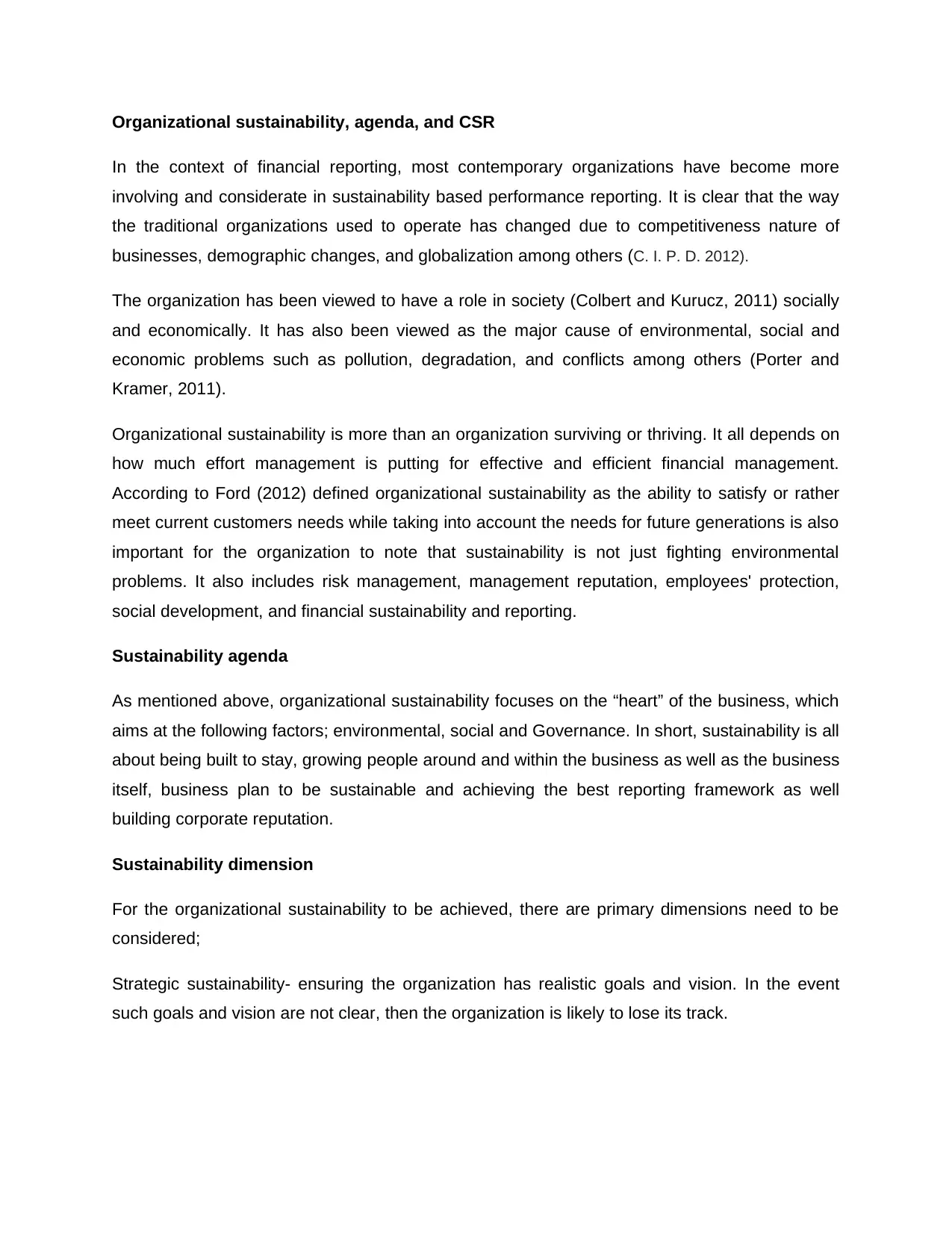
Organizational sustainability, agenda, and CSR
In the context of financial reporting, most contemporary organizations have become more
involving and considerate in sustainability based performance reporting. It is clear that the way
the traditional organizations used to operate has changed due to competitiveness nature of
businesses, demographic changes, and globalization among others (C. I. P. D. 2012).
The organization has been viewed to have a role in society (Colbert and Kurucz, 2011) socially
and economically. It has also been viewed as the major cause of environmental, social and
economic problems such as pollution, degradation, and conflicts among others (Porter and
Kramer, 2011).
Organizational sustainability is more than an organization surviving or thriving. It all depends on
how much effort management is putting for effective and efficient financial management.
According to Ford (2012) defined organizational sustainability as the ability to satisfy or rather
meet current customers needs while taking into account the needs for future generations is also
important for the organization to note that sustainability is not just fighting environmental
problems. It also includes risk management, management reputation, employees' protection,
social development, and financial sustainability and reporting.
Sustainability agenda
As mentioned above, organizational sustainability focuses on the “heart” of the business, which
aims at the following factors; environmental, social and Governance. In short, sustainability is all
about being built to stay, growing people around and within the business as well as the business
itself, business plan to be sustainable and achieving the best reporting framework as well
building corporate reputation.
Sustainability dimension
For the organizational sustainability to be achieved, there are primary dimensions need to be
considered;
Strategic sustainability- ensuring the organization has realistic goals and vision. In the event
such goals and vision are not clear, then the organization is likely to lose its track.
In the context of financial reporting, most contemporary organizations have become more
involving and considerate in sustainability based performance reporting. It is clear that the way
the traditional organizations used to operate has changed due to competitiveness nature of
businesses, demographic changes, and globalization among others (C. I. P. D. 2012).
The organization has been viewed to have a role in society (Colbert and Kurucz, 2011) socially
and economically. It has also been viewed as the major cause of environmental, social and
economic problems such as pollution, degradation, and conflicts among others (Porter and
Kramer, 2011).
Organizational sustainability is more than an organization surviving or thriving. It all depends on
how much effort management is putting for effective and efficient financial management.
According to Ford (2012) defined organizational sustainability as the ability to satisfy or rather
meet current customers needs while taking into account the needs for future generations is also
important for the organization to note that sustainability is not just fighting environmental
problems. It also includes risk management, management reputation, employees' protection,
social development, and financial sustainability and reporting.
Sustainability agenda
As mentioned above, organizational sustainability focuses on the “heart” of the business, which
aims at the following factors; environmental, social and Governance. In short, sustainability is all
about being built to stay, growing people around and within the business as well as the business
itself, business plan to be sustainable and achieving the best reporting framework as well
building corporate reputation.
Sustainability dimension
For the organizational sustainability to be achieved, there are primary dimensions need to be
considered;
Strategic sustainability- ensuring the organization has realistic goals and vision. In the event
such goals and vision are not clear, then the organization is likely to lose its track.
Paraphrase This Document
Need a fresh take? Get an instant paraphrase of this document with our AI Paraphraser
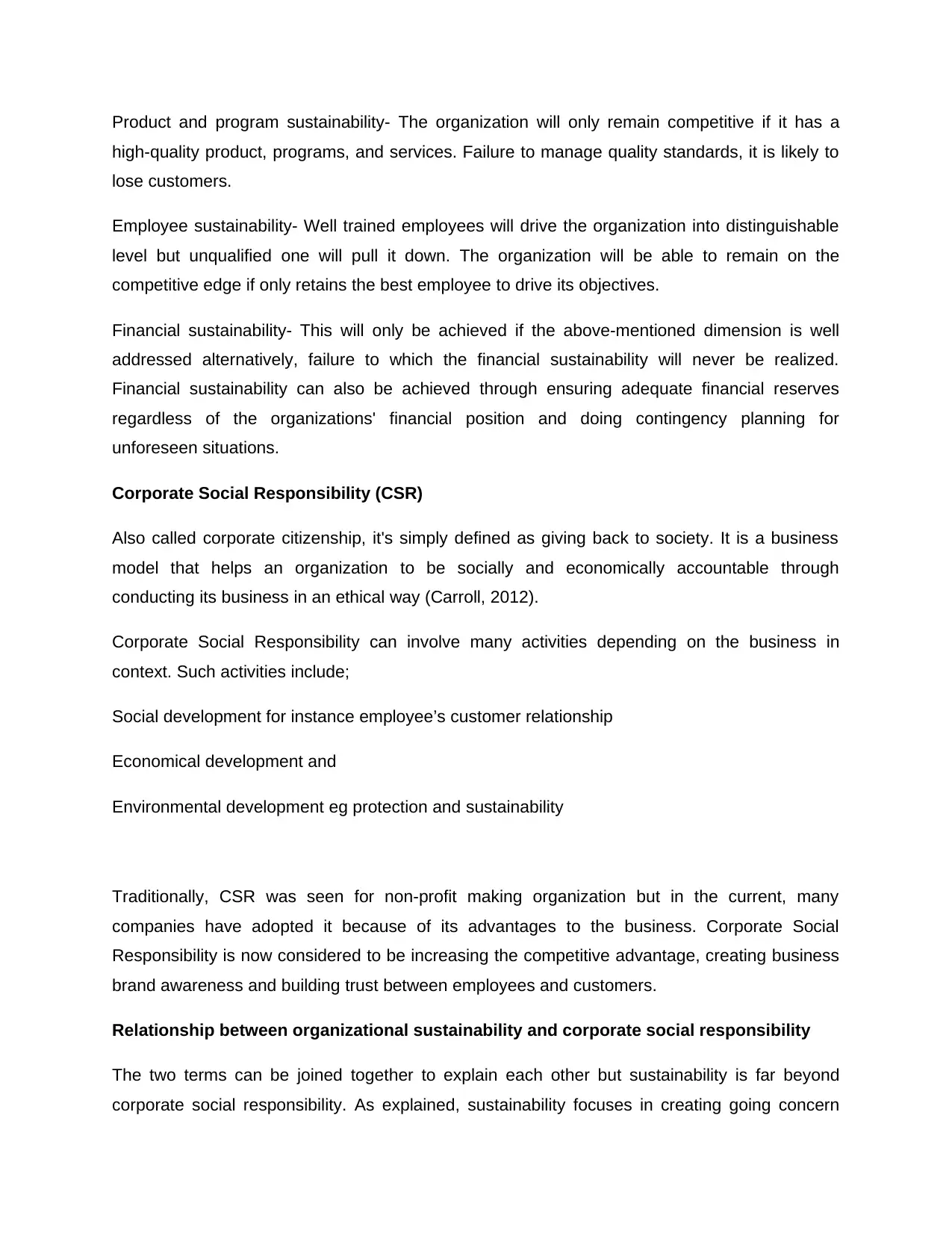
Product and program sustainability- The organization will only remain competitive if it has a
high-quality product, programs, and services. Failure to manage quality standards, it is likely to
lose customers.
Employee sustainability- Well trained employees will drive the organization into distinguishable
level but unqualified one will pull it down. The organization will be able to remain on the
competitive edge if only retains the best employee to drive its objectives.
Financial sustainability- This will only be achieved if the above-mentioned dimension is well
addressed alternatively, failure to which the financial sustainability will never be realized.
Financial sustainability can also be achieved through ensuring adequate financial reserves
regardless of the organizations' financial position and doing contingency planning for
unforeseen situations.
Corporate Social Responsibility (CSR)
Also called corporate citizenship, it's simply defined as giving back to society. It is a business
model that helps an organization to be socially and economically accountable through
conducting its business in an ethical way (Carroll, 2012).
Corporate Social Responsibility can involve many activities depending on the business in
context. Such activities include;
Social development for instance employee’s customer relationship
Economical development and
Environmental development eg protection and sustainability
Traditionally, CSR was seen for non-profit making organization but in the current, many
companies have adopted it because of its advantages to the business. Corporate Social
Responsibility is now considered to be increasing the competitive advantage, creating business
brand awareness and building trust between employees and customers.
Relationship between organizational sustainability and corporate social responsibility
The two terms can be joined together to explain each other but sustainability is far beyond
corporate social responsibility. As explained, sustainability focuses in creating going concern
high-quality product, programs, and services. Failure to manage quality standards, it is likely to
lose customers.
Employee sustainability- Well trained employees will drive the organization into distinguishable
level but unqualified one will pull it down. The organization will be able to remain on the
competitive edge if only retains the best employee to drive its objectives.
Financial sustainability- This will only be achieved if the above-mentioned dimension is well
addressed alternatively, failure to which the financial sustainability will never be realized.
Financial sustainability can also be achieved through ensuring adequate financial reserves
regardless of the organizations' financial position and doing contingency planning for
unforeseen situations.
Corporate Social Responsibility (CSR)
Also called corporate citizenship, it's simply defined as giving back to society. It is a business
model that helps an organization to be socially and economically accountable through
conducting its business in an ethical way (Carroll, 2012).
Corporate Social Responsibility can involve many activities depending on the business in
context. Such activities include;
Social development for instance employee’s customer relationship
Economical development and
Environmental development eg protection and sustainability
Traditionally, CSR was seen for non-profit making organization but in the current, many
companies have adopted it because of its advantages to the business. Corporate Social
Responsibility is now considered to be increasing the competitive advantage, creating business
brand awareness and building trust between employees and customers.
Relationship between organizational sustainability and corporate social responsibility
The two terms can be joined together to explain each other but sustainability is far beyond
corporate social responsibility. As explained, sustainability focuses in creating going concern
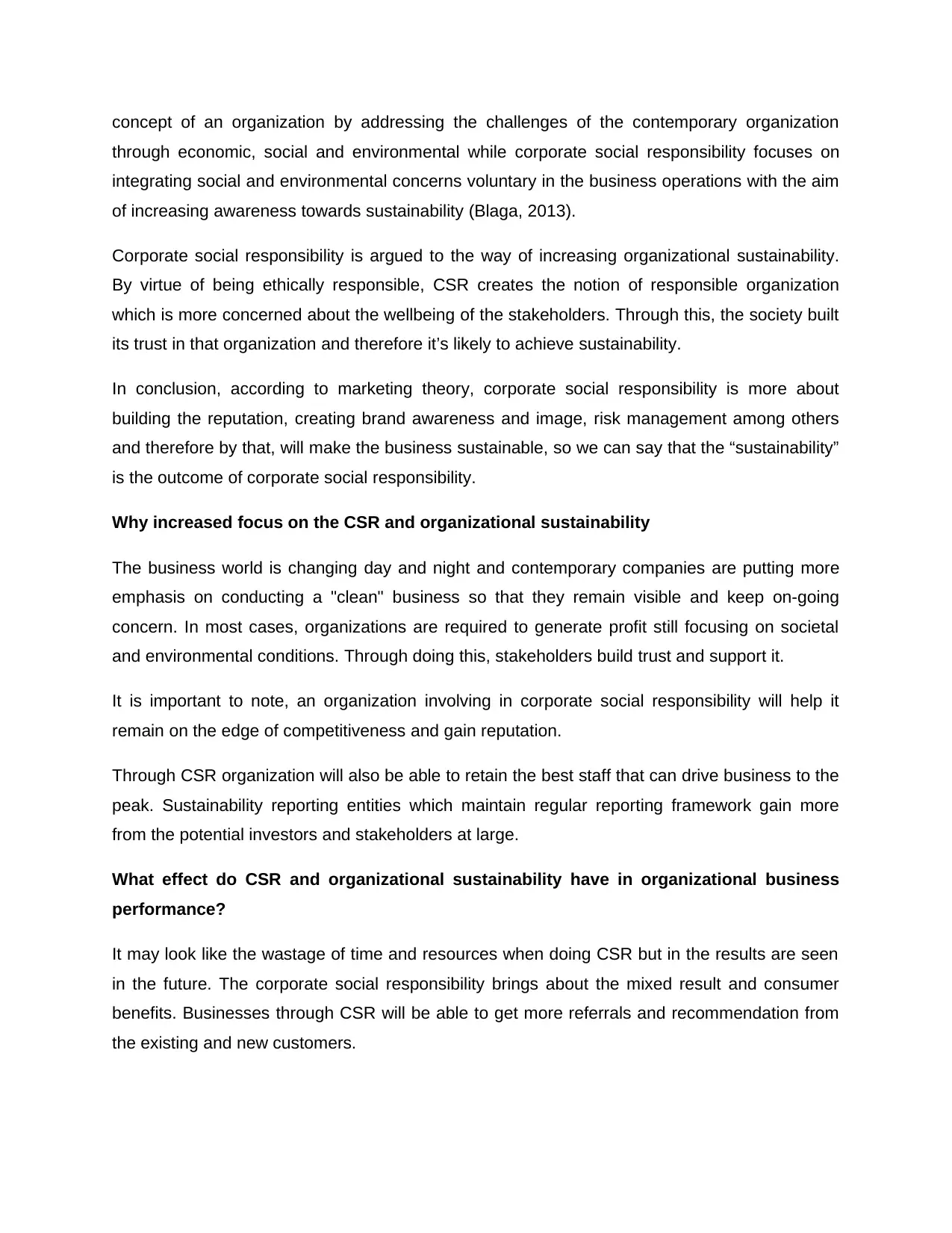
concept of an organization by addressing the challenges of the contemporary organization
through economic, social and environmental while corporate social responsibility focuses on
integrating social and environmental concerns voluntary in the business operations with the aim
of increasing awareness towards sustainability (Blaga, 2013).
Corporate social responsibility is argued to the way of increasing organizational sustainability.
By virtue of being ethically responsible, CSR creates the notion of responsible organization
which is more concerned about the wellbeing of the stakeholders. Through this, the society built
its trust in that organization and therefore it’s likely to achieve sustainability.
In conclusion, according to marketing theory, corporate social responsibility is more about
building the reputation, creating brand awareness and image, risk management among others
and therefore by that, will make the business sustainable, so we can say that the “sustainability”
is the outcome of corporate social responsibility.
Why increased focus on the CSR and organizational sustainability
The business world is changing day and night and contemporary companies are putting more
emphasis on conducting a "clean" business so that they remain visible and keep on-going
concern. In most cases, organizations are required to generate profit still focusing on societal
and environmental conditions. Through doing this, stakeholders build trust and support it.
It is important to note, an organization involving in corporate social responsibility will help it
remain on the edge of competitiveness and gain reputation.
Through CSR organization will also be able to retain the best staff that can drive business to the
peak. Sustainability reporting entities which maintain regular reporting framework gain more
from the potential investors and stakeholders at large.
What effect do CSR and organizational sustainability have in organizational business
performance?
It may look like the wastage of time and resources when doing CSR but in the results are seen
in the future. The corporate social responsibility brings about the mixed result and consumer
benefits. Businesses through CSR will be able to get more referrals and recommendation from
the existing and new customers.
through economic, social and environmental while corporate social responsibility focuses on
integrating social and environmental concerns voluntary in the business operations with the aim
of increasing awareness towards sustainability (Blaga, 2013).
Corporate social responsibility is argued to the way of increasing organizational sustainability.
By virtue of being ethically responsible, CSR creates the notion of responsible organization
which is more concerned about the wellbeing of the stakeholders. Through this, the society built
its trust in that organization and therefore it’s likely to achieve sustainability.
In conclusion, according to marketing theory, corporate social responsibility is more about
building the reputation, creating brand awareness and image, risk management among others
and therefore by that, will make the business sustainable, so we can say that the “sustainability”
is the outcome of corporate social responsibility.
Why increased focus on the CSR and organizational sustainability
The business world is changing day and night and contemporary companies are putting more
emphasis on conducting a "clean" business so that they remain visible and keep on-going
concern. In most cases, organizations are required to generate profit still focusing on societal
and environmental conditions. Through doing this, stakeholders build trust and support it.
It is important to note, an organization involving in corporate social responsibility will help it
remain on the edge of competitiveness and gain reputation.
Through CSR organization will also be able to retain the best staff that can drive business to the
peak. Sustainability reporting entities which maintain regular reporting framework gain more
from the potential investors and stakeholders at large.
What effect do CSR and organizational sustainability have in organizational business
performance?
It may look like the wastage of time and resources when doing CSR but in the results are seen
in the future. The corporate social responsibility brings about the mixed result and consumer
benefits. Businesses through CSR will be able to get more referrals and recommendation from
the existing and new customers.
⊘ This is a preview!⊘
Do you want full access?
Subscribe today to unlock all pages.

Trusted by 1+ million students worldwide
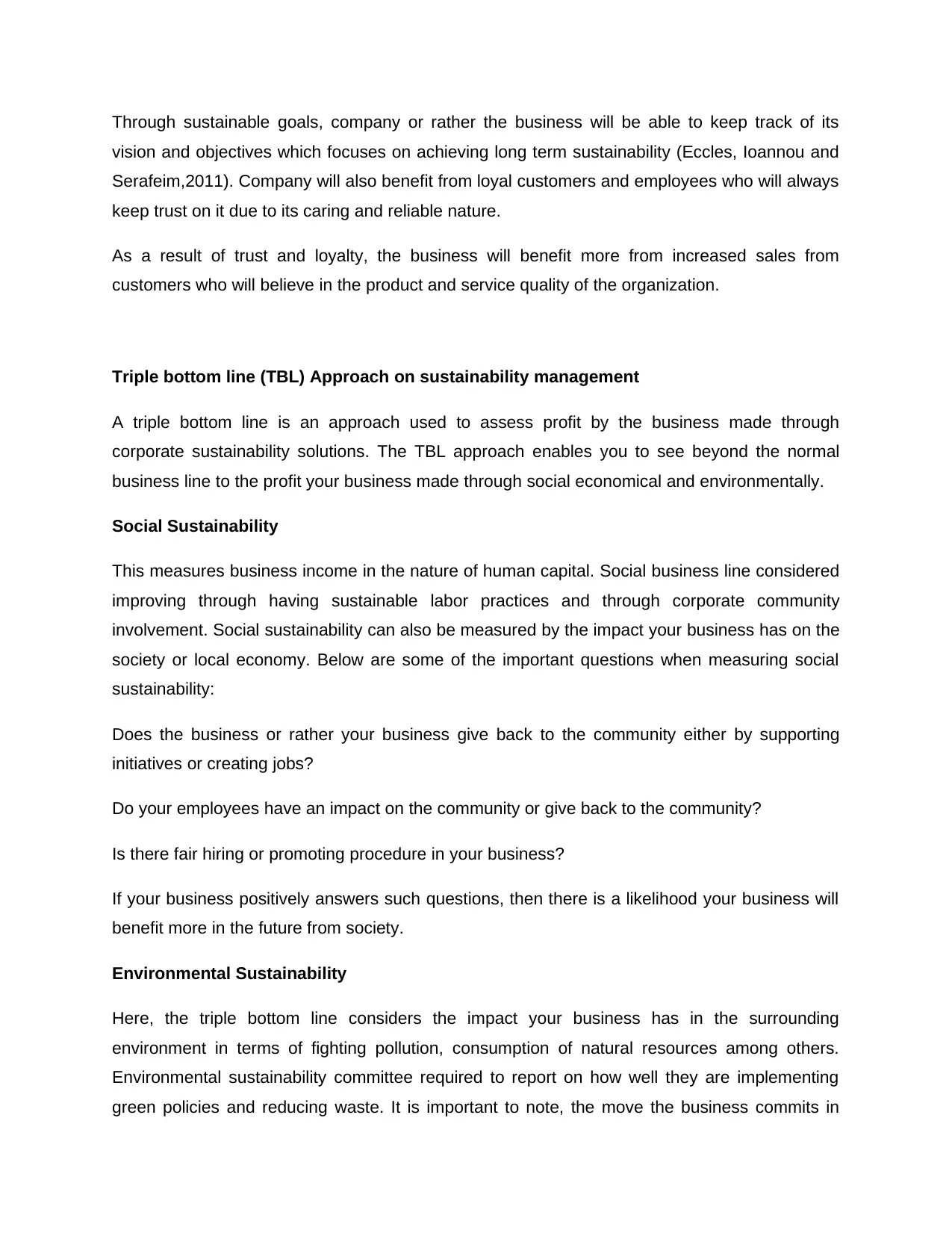
Through sustainable goals, company or rather the business will be able to keep track of its
vision and objectives which focuses on achieving long term sustainability (Eccles, Ioannou and
Serafeim,2011). Company will also benefit from loyal customers and employees who will always
keep trust on it due to its caring and reliable nature.
As a result of trust and loyalty, the business will benefit more from increased sales from
customers who will believe in the product and service quality of the organization.
Triple bottom line (TBL) Approach on sustainability management
A triple bottom line is an approach used to assess profit by the business made through
corporate sustainability solutions. The TBL approach enables you to see beyond the normal
business line to the profit your business made through social economical and environmentally.
Social Sustainability
This measures business income in the nature of human capital. Social business line considered
improving through having sustainable labor practices and through corporate community
involvement. Social sustainability can also be measured by the impact your business has on the
society or local economy. Below are some of the important questions when measuring social
sustainability:
Does the business or rather your business give back to the community either by supporting
initiatives or creating jobs?
Do your employees have an impact on the community or give back to the community?
Is there fair hiring or promoting procedure in your business?
If your business positively answers such questions, then there is a likelihood your business will
benefit more in the future from society.
Environmental Sustainability
Here, the triple bottom line considers the impact your business has in the surrounding
environment in terms of fighting pollution, consumption of natural resources among others.
Environmental sustainability committee required to report on how well they are implementing
green policies and reducing waste. It is important to note, the move the business commits in
vision and objectives which focuses on achieving long term sustainability (Eccles, Ioannou and
Serafeim,2011). Company will also benefit from loyal customers and employees who will always
keep trust on it due to its caring and reliable nature.
As a result of trust and loyalty, the business will benefit more from increased sales from
customers who will believe in the product and service quality of the organization.
Triple bottom line (TBL) Approach on sustainability management
A triple bottom line is an approach used to assess profit by the business made through
corporate sustainability solutions. The TBL approach enables you to see beyond the normal
business line to the profit your business made through social economical and environmentally.
Social Sustainability
This measures business income in the nature of human capital. Social business line considered
improving through having sustainable labor practices and through corporate community
involvement. Social sustainability can also be measured by the impact your business has on the
society or local economy. Below are some of the important questions when measuring social
sustainability:
Does the business or rather your business give back to the community either by supporting
initiatives or creating jobs?
Do your employees have an impact on the community or give back to the community?
Is there fair hiring or promoting procedure in your business?
If your business positively answers such questions, then there is a likelihood your business will
benefit more in the future from society.
Environmental Sustainability
Here, the triple bottom line considers the impact your business has in the surrounding
environment in terms of fighting pollution, consumption of natural resources among others.
Environmental sustainability committee required to report on how well they are implementing
green policies and reducing waste. It is important to note, the move the business commits in
Paraphrase This Document
Need a fresh take? Get an instant paraphrase of this document with our AI Paraphraser
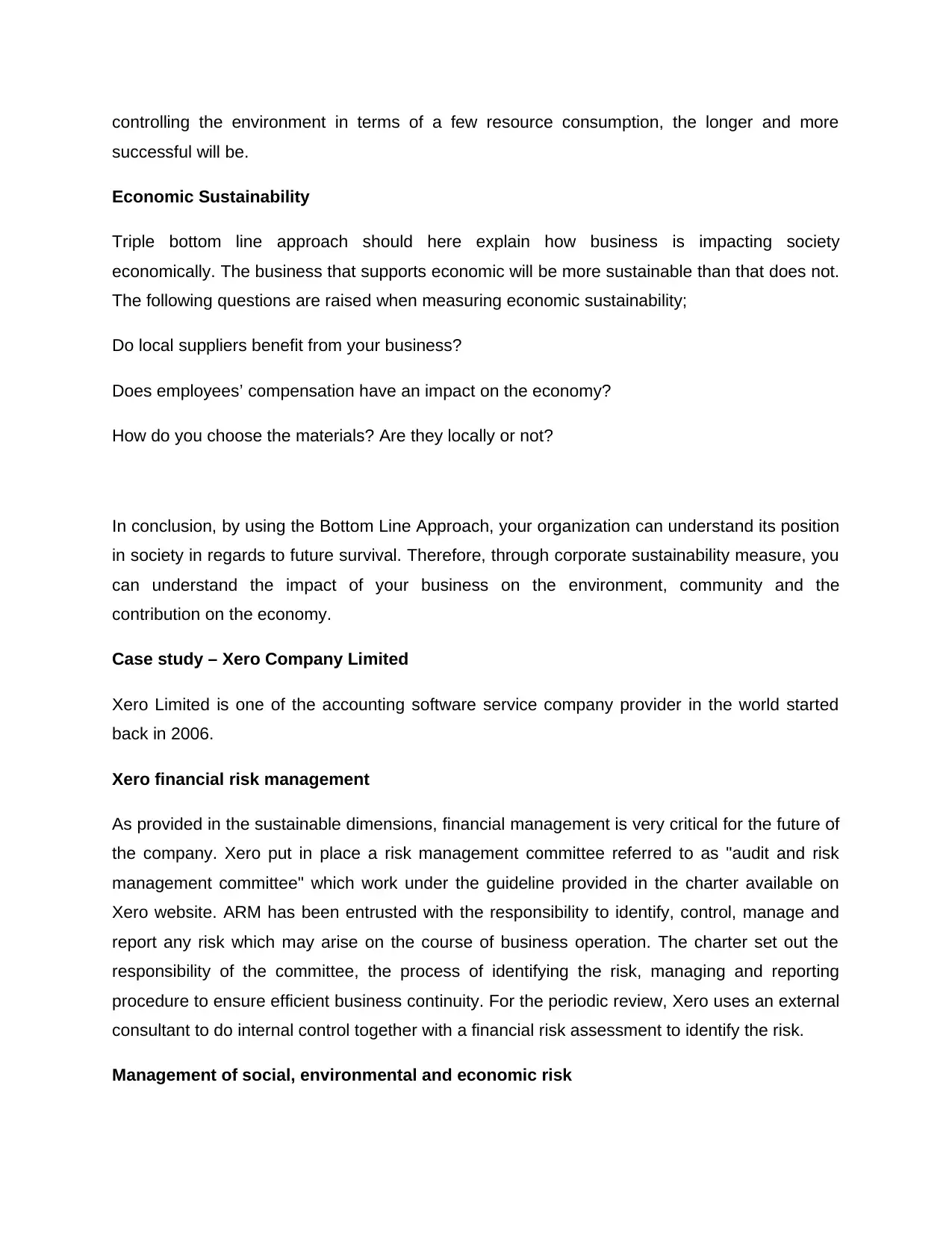
controlling the environment in terms of a few resource consumption, the longer and more
successful will be.
Economic Sustainability
Triple bottom line approach should here explain how business is impacting society
economically. The business that supports economic will be more sustainable than that does not.
The following questions are raised when measuring economic sustainability;
Do local suppliers benefit from your business?
Does employees’ compensation have an impact on the economy?
How do you choose the materials? Are they locally or not?
In conclusion, by using the Bottom Line Approach, your organization can understand its position
in society in regards to future survival. Therefore, through corporate sustainability measure, you
can understand the impact of your business on the environment, community and the
contribution on the economy.
Case study – Xero Company Limited
Xero Limited is one of the accounting software service company provider in the world started
back in 2006.
Xero financial risk management
As provided in the sustainable dimensions, financial management is very critical for the future of
the company. Xero put in place a risk management committee referred to as "audit and risk
management committee" which work under the guideline provided in the charter available on
Xero website. ARM has been entrusted with the responsibility to identify, control, manage and
report any risk which may arise on the course of business operation. The charter set out the
responsibility of the committee, the process of identifying the risk, managing and reporting
procedure to ensure efficient business continuity. For the periodic review, Xero uses an external
consultant to do internal control together with a financial risk assessment to identify the risk.
Management of social, environmental and economic risk
successful will be.
Economic Sustainability
Triple bottom line approach should here explain how business is impacting society
economically. The business that supports economic will be more sustainable than that does not.
The following questions are raised when measuring economic sustainability;
Do local suppliers benefit from your business?
Does employees’ compensation have an impact on the economy?
How do you choose the materials? Are they locally or not?
In conclusion, by using the Bottom Line Approach, your organization can understand its position
in society in regards to future survival. Therefore, through corporate sustainability measure, you
can understand the impact of your business on the environment, community and the
contribution on the economy.
Case study – Xero Company Limited
Xero Limited is one of the accounting software service company provider in the world started
back in 2006.
Xero financial risk management
As provided in the sustainable dimensions, financial management is very critical for the future of
the company. Xero put in place a risk management committee referred to as "audit and risk
management committee" which work under the guideline provided in the charter available on
Xero website. ARM has been entrusted with the responsibility to identify, control, manage and
report any risk which may arise on the course of business operation. The charter set out the
responsibility of the committee, the process of identifying the risk, managing and reporting
procedure to ensure efficient business continuity. For the periodic review, Xero uses an external
consultant to do internal control together with a financial risk assessment to identify the risk.
Management of social, environmental and economic risk
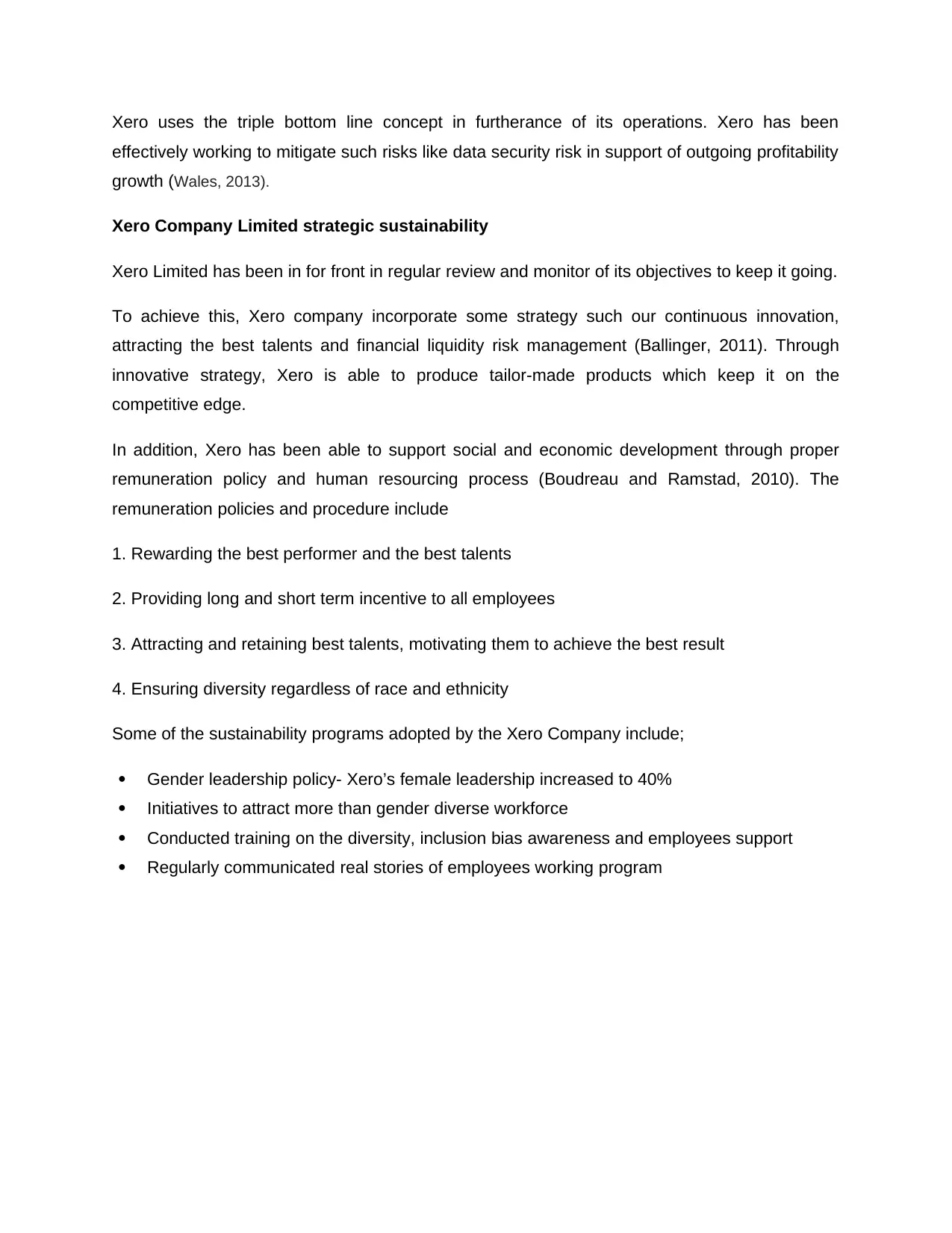
Xero uses the triple bottom line concept in furtherance of its operations. Xero has been
effectively working to mitigate such risks like data security risk in support of outgoing profitability
growth (Wales, 2013).
Xero Company Limited strategic sustainability
Xero Limited has been in for front in regular review and monitor of its objectives to keep it going.
To achieve this, Xero company incorporate some strategy such our continuous innovation,
attracting the best talents and financial liquidity risk management (Ballinger, 2011). Through
innovative strategy, Xero is able to produce tailor-made products which keep it on the
competitive edge.
In addition, Xero has been able to support social and economic development through proper
remuneration policy and human resourcing process (Boudreau and Ramstad, 2010). The
remuneration policies and procedure include
1. Rewarding the best performer and the best talents
2. Providing long and short term incentive to all employees
3. Attracting and retaining best talents, motivating them to achieve the best result
4. Ensuring diversity regardless of race and ethnicity
Some of the sustainability programs adopted by the Xero Company include;
Gender leadership policy- Xero’s female leadership increased to 40%
Initiatives to attract more than gender diverse workforce
Conducted training on the diversity, inclusion bias awareness and employees support
Regularly communicated real stories of employees working program
effectively working to mitigate such risks like data security risk in support of outgoing profitability
growth (Wales, 2013).
Xero Company Limited strategic sustainability
Xero Limited has been in for front in regular review and monitor of its objectives to keep it going.
To achieve this, Xero company incorporate some strategy such our continuous innovation,
attracting the best talents and financial liquidity risk management (Ballinger, 2011). Through
innovative strategy, Xero is able to produce tailor-made products which keep it on the
competitive edge.
In addition, Xero has been able to support social and economic development through proper
remuneration policy and human resourcing process (Boudreau and Ramstad, 2010). The
remuneration policies and procedure include
1. Rewarding the best performer and the best talents
2. Providing long and short term incentive to all employees
3. Attracting and retaining best talents, motivating them to achieve the best result
4. Ensuring diversity regardless of race and ethnicity
Some of the sustainability programs adopted by the Xero Company include;
Gender leadership policy- Xero’s female leadership increased to 40%
Initiatives to attract more than gender diverse workforce
Conducted training on the diversity, inclusion bias awareness and employees support
Regularly communicated real stories of employees working program
⊘ This is a preview!⊘
Do you want full access?
Subscribe today to unlock all pages.

Trusted by 1+ million students worldwide
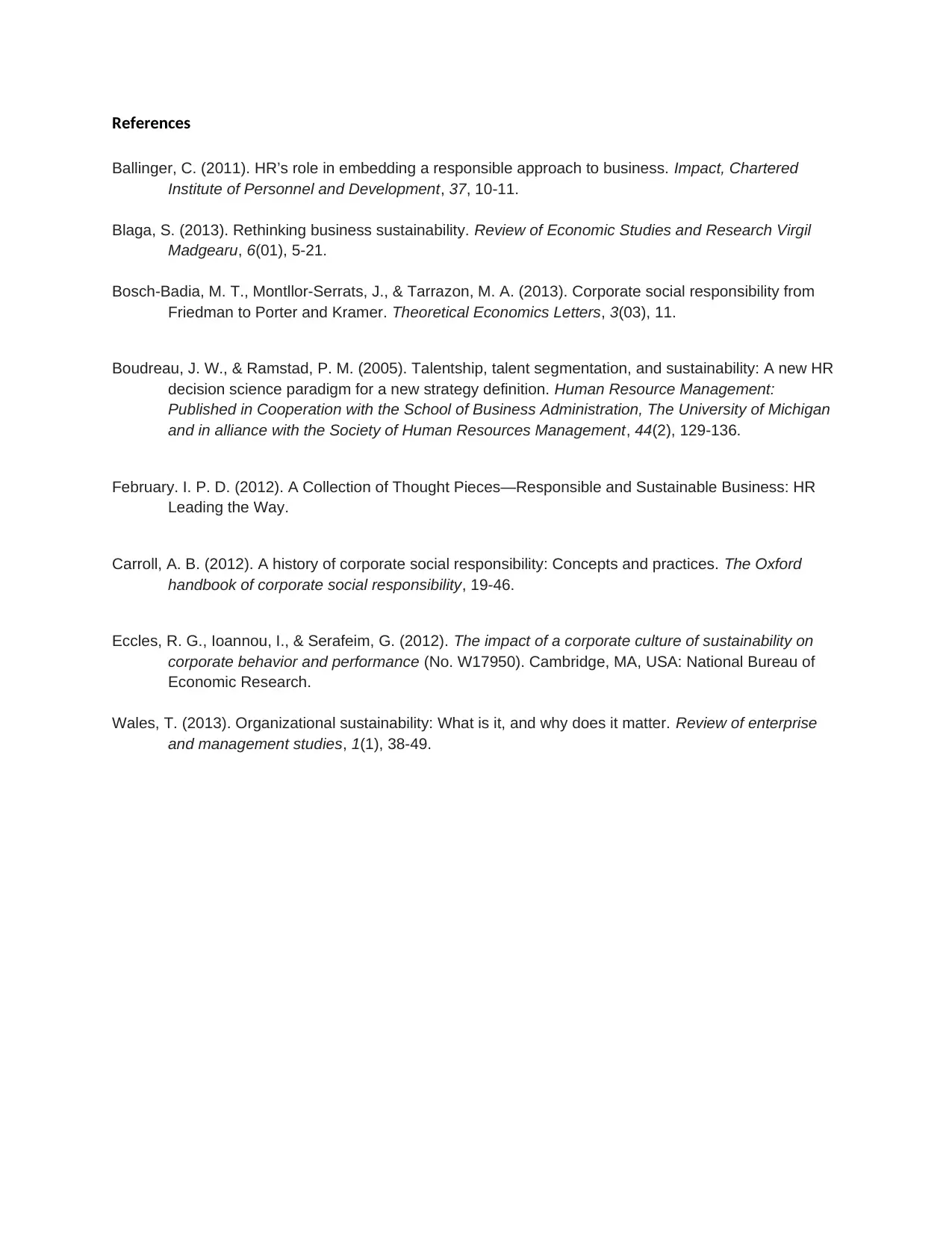
References
Ballinger, C. (2011). HR’s role in embedding a responsible approach to business. Impact, Chartered
Institute of Personnel and Development, 37, 10-11.
Blaga, S. (2013). Rethinking business sustainability. Review of Economic Studies and Research Virgil
Madgearu, 6(01), 5-21.
Bosch-Badia, M. T., Montllor-Serrats, J., & Tarrazon, M. A. (2013). Corporate social responsibility from
Friedman to Porter and Kramer. Theoretical Economics Letters, 3(03), 11.
Boudreau, J. W., & Ramstad, P. M. (2005). Talentship, talent segmentation, and sustainability: A new HR
decision science paradigm for a new strategy definition. Human Resource Management:
Published in Cooperation with the School of Business Administration, The University of Michigan
and in alliance with the Society of Human Resources Management, 44(2), 129-136.
February. I. P. D. (2012). A Collection of Thought Pieces—Responsible and Sustainable Business: HR
Leading the Way.
Carroll, A. B. (2012). A history of corporate social responsibility: Concepts and practices. The Oxford
handbook of corporate social responsibility, 19-46.
Eccles, R. G., Ioannou, I., & Serafeim, G. (2012). The impact of a corporate culture of sustainability on
corporate behavior and performance (No. W17950). Cambridge, MA, USA: National Bureau of
Economic Research.
Wales, T. (2013). Organizational sustainability: What is it, and why does it matter. Review of enterprise
and management studies, 1(1), 38-49.
Ballinger, C. (2011). HR’s role in embedding a responsible approach to business. Impact, Chartered
Institute of Personnel and Development, 37, 10-11.
Blaga, S. (2013). Rethinking business sustainability. Review of Economic Studies and Research Virgil
Madgearu, 6(01), 5-21.
Bosch-Badia, M. T., Montllor-Serrats, J., & Tarrazon, M. A. (2013). Corporate social responsibility from
Friedman to Porter and Kramer. Theoretical Economics Letters, 3(03), 11.
Boudreau, J. W., & Ramstad, P. M. (2005). Talentship, talent segmentation, and sustainability: A new HR
decision science paradigm for a new strategy definition. Human Resource Management:
Published in Cooperation with the School of Business Administration, The University of Michigan
and in alliance with the Society of Human Resources Management, 44(2), 129-136.
February. I. P. D. (2012). A Collection of Thought Pieces—Responsible and Sustainable Business: HR
Leading the Way.
Carroll, A. B. (2012). A history of corporate social responsibility: Concepts and practices. The Oxford
handbook of corporate social responsibility, 19-46.
Eccles, R. G., Ioannou, I., & Serafeim, G. (2012). The impact of a corporate culture of sustainability on
corporate behavior and performance (No. W17950). Cambridge, MA, USA: National Bureau of
Economic Research.
Wales, T. (2013). Organizational sustainability: What is it, and why does it matter. Review of enterprise
and management studies, 1(1), 38-49.
1 out of 7
Related Documents
Your All-in-One AI-Powered Toolkit for Academic Success.
+13062052269
info@desklib.com
Available 24*7 on WhatsApp / Email
![[object Object]](/_next/static/media/star-bottom.7253800d.svg)
Unlock your academic potential
Copyright © 2020–2025 A2Z Services. All Rights Reserved. Developed and managed by ZUCOL.





